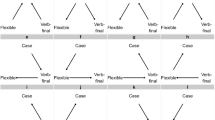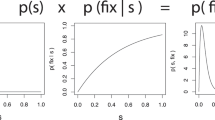Abstract
A central goal of linguistics is to understand how words evolve. Past research has found that macro-level factors such as frequency of word usage and population size explain the pace of lexical evolution. Here we focus on cognitive and affective factors, testing whether valence (positivity–negativity) explains lexical evolution rates. Using estimates of cognate replacement rates for 200 concepts on an Indo-European language tree spanning six to ten millennia, we find that negative valence correlates with faster cognate replacement. This association holds when controlling for frequency of use, and follow-up analyses show that it is most robust for adjectives (‘dirty’ versus ‘clean’; ‘bad’ versus ‘good’); it does not consistently reach statistical significance for verbs, and never reaches significance for nouns. We also present experiments showing that individuals are more likely to replace words for negative versus positive concepts. Our findings suggest that emotional valence affects micro-level guided variation, which drives macro-level valence-dependent mutation in adjectives.
This is a preview of subscription content, access via your institution
Access options
Access Nature and 54 other Nature Portfolio journals
Get Nature+, our best-value online-access subscription
$29.99 / 30 days
cancel any time
Subscribe to this journal
Receive 12 digital issues and online access to articles
$119.00 per year
only $9.92 per issue
Buy this article
- Purchase on Springer Link
- Instant access to full article PDF
Prices may be subject to local taxes which are calculated during checkout



Similar content being viewed by others
Data availability
Our project page at https://osf.io/f86wt/ displays all data from this paper. Our analyses used external data from WOLD (https://wold.clld.org/) and from Pagel, Atkinson and Meade (https://www.nature.com/articles/nature06176?message=remove&pagewanted=all).
Code availability
Our project page at https://osf.io/f86wt/ displays all code from this paper.
References
Lewis, M. P. Ethnologue: Languages of the World (SIL International, 2009).
Croft, W. Evolutionary linguistics. Annu. Rev. Anthropol. 37, 219–234 (2008).
Pagel, M. Human language as a culturally transmitted replicator. Nat. Rev. Genet. 10, 405–415 (2009).
Gray, R. D. & Atkinson, Q. D. Language-tree divergence times support the Anatolian theory of Indo-European origin. Nature 426, 435–439 (2003).
Jackson, J. C. et al. From text to thought: how analyzing language can advance psychological science. Perspect. Psychol. Sci. 17, 805–826 (2021).
Dor, D. & Jablonka, E. From cultural selection to genetic selection: a framework for the evolution of language. Selection 1, 33–56 (2001).
Jablonka, E. & Lamb, M. J. Précis of evolution in four dimensions. Behav. Brain Sci. 30, 353 (2007).
Boyd, R. & Richerson, P. J. Culture and the Evolutionary Process (Univ. Chicago Press, 1988).
Sperber, D. Explaining Culture: A Naturalistic Approach (Blackwell, 1996).
Mesoudi, A. & Whiten, A. The multiple roles of cultural transmission experiments in understanding human cultural evolution. Philos. Trans. R. Soc. B 363, 3489–3501 (2008).
Acerbi, A. & Alexander Bentley, R. Biases in cultural transmission shape the turnover of popular traits. Evol. Hum. Behav. 35, 228–236 (2014).
Bebbington, K., MacLeod, C., Ellison, T. M. & Fay, N. The sky is falling: evidence of a negativity bias in the social transmission of information. Evol. Hum. Behav. 38, 92–101 (2017).
Berger, J. Arousal increases social transmission of information. Psychol. Sci. 22, 891–893 (2011).
Pennebaker, J. W., Mehl, M. R. & Niederhoffer, K. G. Psychological aspects of natural language use: our words, our selves. Annu. Rev. Psychol. 54, 547–577 (2003).
Nettle, D. Is the rate of linguistic change constant? Lingua 108, 119–136 (1999).
Thomason, S. G. Language change and language contact. Encycl. Lang. Linguist. 6, 339–347 (2006).
Pagel, M., Atkinson, Q. D. & Meade, A. Frequency of word-use predicts rates of lexical evolution throughout Indo-European history. Nature 449, 717–720 (2007).
Wichmann, S. & Holman, E. W. in Approaches to Measuring Linguistic Differences (eds Borin, L. & Saxena, A.) (De Gruyter, 2013).
Monaghan, P. Age of acquisition predicts rate of lexical evolution. Cognition 133, 530–534 (2014).
Vejdemo, S. & Hörberg, T. Semantic factors predict the rate of lexical replacement of content words. PLoS ONE 11, e0147924 (2016).
Baumeister, R. F., Bratslavsky, E., Finkenauer, C. & Vohs, K. D. Bad is stronger than good. Rev. Gen. Psychol. 5, 323–370 (2001).
Jefferies, L. N., Smilek, D., Eich, E. & Enns, J. T. Emotional valence and arousal interact in attentional control. Psychol. Sci. 19, 290–295 (2008).
Kuperman, V., Estes, Z., Brysbaert, M. & Warriner, A. B. Emotion and language: valence and arousal affect word recognition. J. Exp. Psychol. Gen. 143, 1065 (2014).
Jackson, J. C. et al. Emotion semantics show both cultural variation and universal structure. Science 366, 1517–1522 (2019).
Di Natale, A., Pellert, M. & Garcia, D. Colexification networks encode affective meaning. Affect. Sci. 2, 99–111 (2021).
Eimer, M. & Holmes, A. Event-related brain potential correlates of emotional face processing. Neuropsychologia 45, 15–31 (2007).
Fischler, I. & Bradley, M. Event-related potential studies of language and emotion: words, phrases, and task effects. Prog. Brain Res. 156, 185–203 (2006).
Schupp, H. T., Junghöfer, M., Weike, A. I. & Hamm, A. O. The selective processing of briefly presented affective pictures: an ERP analysis. Psychophysiology 41, 441–449 (2004).
Osgood, C. E., & Tzeng, O. C. S. (eds). Language, Meaning, and Culture: The Selected Papers of C. E. Osgood (Praeger, 1990).
Bloom, P. How Children Learn the Meanings of Words (MIT Press, 2002).
Broze, Y. & Shanahan, D. Diachronic changes in jazz harmony: a cognitive perspective. Music Percept. Interdiscip. J. 31, 32–45 (2013).
DeWall, C. N., Pond, R. S. Jr, Campbell, W. K. & Twenge, J. M. Tuning in to psychological change: linguistic markers of psychological traits and emotions over time in popular US song lyrics. Psychol. Aesthet. Creat. Arts 5, 200 (2011).
Morin, O. & Acerbi, A. Birth of the cool: a two-centuries decline in emotional expression in Anglophone fiction. Cogn. Emot. 31, 1663–1675 (2017).
Pratto, F. & John, O. P. Automatic vigilance: the attention-grabbing power of negative social information. J. Pers. Soc. Psychol. 61, 380 (1991).
Fiske, S. T. Attention and weight in person perception: the impact of negative and extreme behavior. J. Pers. Soc. Psychol. 38, 889 (1980).
Brady, W. J., Crockett, M. J. & Van Bavel, J. J. The MAD model of moral contagion: the role of motivation, attention, and design in the spread of moralized content online. Perspect. Psychol. Sci. 15, 978–1010 (2020).
Taylor, S. E. Asymmetrical effects of positive and negative events: the mobilization-minimization hypothesis. Psychol. Bull. 110, 67 (1991).
Bless, H. & Fiedler, K. Mood and the regulation of information processing and behavior. in Affect in Social Thinking and Behavior (ed Forgas, J. P.) 65–84 (Psychology Press, 2006).
Forgas, J. P. Feeling and doing: affective influences on interpersonal behavior. Psychol. Inq. 13, 1–28 (2002).
Schwarz, N. & Bless, H. in Emotion and Social Judgments (ed Forgas, J. P.) 55–71 (Garland Science, 2020).
Matlin, M. W. & Stang, D. J. The Pollyanna Principle: Selectivity in Language, Memory, and Thought (Schenkman, 1978).
Forgas, J. P. Mood and the perception of unusual people: affective asymmetry in memory and social judgments. Eur. J. Soc. Psychol. 22, 531–547 (1992).
Warriner, A. B., Kuperman, V. & Brysbaert, M. Norms of valence, arousal, and dominance for 13,915 English lemmas. Behav. Res. Methods 45, 1191–1207 (2013).
Stadthagen-Gonzalez, H. et al. Norms of valence and arousal for 14,031 Spanish words. Behav. Res. Methods 49, 111–123 (2017).
Imbir, K. K. Affective norms for 4900 Polish Words Reload (ANPW_R): assessments for valence, arousal, dominance, origin, significance, concreteness, imageability and, age of acquisition. Front. Psychol. 7, 1081 (2016).
Moors, A. et al. Norms of valence, arousal, dominance, and age of acquisition for 4,300 Dutch words. Behav. Res. Methods 45, 169–177 (2013).
Swadesh, M. Lexico-statistic dating of prehistoric ethnic contacts: with special reference to North American Indians and Eskimos. Proc. Am. Philos. Soc. 96, 452–463 (1952).
Croft, W. Explaining Language Change: An Evolutionary Approach (Pearson Education, 2000).
Enders, C. K. & Tofighi, D. Centering predictor variables in cross-sectional multilevel models: a new look at an old issue. Psychol. Methods 12, 121 (2007).
Mulkar-Mehta, R., Hobbs, J. & Hovy, E. Granularity in natural language discourse. In Proc. Ninth International Conference on Computational Semantics (IWCS, 2011).
Smidt, K. E. & Suvak, M. K. A brief, but nuanced, review of emotional granularity and emotion differentiation research. Curr. Opin. Psychol. 3, 48–51 (2015).
Tugade, M. M., Fredrickson, B. L. & Barrett, L. F. Psychological resilience and positive emotional granularity: examining the benefits of positive emotions on coping and health. J. Pers. 72, 1161–1190 (2004).
Averill, J. R. A Semantic Atlas of Emotional Concepts (Am. Psychol. Assoc., 1975).
Clore, L. & Ortony, A. in Cognitive Perspectives on Emotion and Motivation (eds Hamilton, V., Bower, G. H. & Frijda, N. H.) 367–397 (Springer, 1988).
Russell, J. A., Fernández-Dols, J. M., Manstead, A. S. R. & Wellenkamp, J. Everyday Conceptions of Emotion (Springer, 1995).
Anderson, N. H. Likableness ratings of 555 personality-trait words. J. Pers. Soc. Psychol. 9, 272–279 (1968).
Alves, H., Koch, A. & Unkelbach, C. Why good is more alike than bad: processing implications. Trends Cogn. Sci. 21, 69–79 (2017).
Harper, D. Etymology, origin and meaning of sleazy by etymonline. Online Etymology Dictionary https://www.etymonline.com/word/sleazy (2000).
Ortony, A., Turner, T. J. & Antos, S. J. A puzzle about affect and recognition memory. J. Exp. Psychol. Learn. Mem. Cogn. 9, 725 (1983).
Echterhoff, G., Higgins, E. T., Kopietz, R. & Groll, S. How communication goals determine when audience tuning biases memory. J. Exp. Psychol. Gen. 137, 3 (2008).
Echterhoff, G., Higgins, E. T. & Groll, S. Audience-tuning effects on memory: the role of shared reality. J. Pers. Soc. Psychol. 89, 257 (2005).
Ye, J., Zhao, L., Huang, Z. & Meng, F. The audience-tuning effect of negative stereotypes in communication. Front. Psychol. 12, 663814 (2021).
Bayliss, C. D., Field, D. & Moxon, E. R. The simple sequence contingency loci of Haemophilus influenzae and Neisseria meningitidis. J. Clin. Invest. 107, 657–666 (2001).
Lieberman, M. D. Social: Why Our Brains Are Wired to Connect (Crown, 2013).
Davies, M. Corpus del español: 10 billion words: dialects / genres / historical. https://www.corpusdelespanol.org/
Haspelmath, M. & Tadmor, U. Loanwords in the World’s Languages: A Comparative Handbook (Walter de Gruyter, 2009).
Acknowledgements
J.W. thanks the Marsden Foundation of New Zealand (19-UOO-1932) for funding. The Marsden foundation played no role in the conceptualization, design, analysis or decision to publish this research. The authors thank I. Khismatova for research assistance.
Author information
Authors and Affiliations
Contributions
J.C.J. conceptualized the study, analysed the data and co-wrote the manuscript. K.L. co-wrote the manuscript. R.D. collected the data. Q.A. co-wrote the manuscript. J.W. conceptualized the study and co-wrote the manuscript.
Corresponding author
Ethics declarations
Competing interests
The authors declare no competing interests.
Peer review
Peer review information
Nature Human Behaviour thanks the anonymous reviewer(s) for their contribution to the peer review of this work. Peer reviewer reports are available.
Additional information
Publisher’s note Springer Nature remains neutral with regard to jurisdictional claims in published maps and institutional affiliations.
Supplementary information
Supplementary Information
Supplementary Figs. 1 and 2, Tables 1–8, methods and results.
Rights and permissions
Springer Nature or its licensor (e.g. a society or other partner) holds exclusive rights to this article under a publishing agreement with the author(s) or other rightsholder(s); author self-archiving of the accepted manuscript version of this article is solely governed by the terms of such publishing agreement and applicable law.
About this article
Cite this article
Jackson, J.C., Lindquist, K., Drabble, R. et al. Valence-dependent mutation in lexical evolution. Nat Hum Behav 7, 190–199 (2023). https://doi.org/10.1038/s41562-022-01483-8
Received:
Accepted:
Published:
Issue Date:
DOI: https://doi.org/10.1038/s41562-022-01483-8
This article is cited by
-
How Male and Female Literary Authors Write About Affect Across Cultures and Over Historical Periods
Affective Science (2023)



